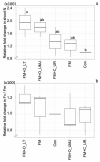Matching of Nitrogen Enhancement and Photosynthetic Efficiency by Arbuscular Mycorrhiza in Maize (Zea mays L.) in Relation to Organic Fertilizer Type
- PMID: 35161350
- PMCID: PMC8838784
- DOI: 10.3390/plants11030369
Matching of Nitrogen Enhancement and Photosynthetic Efficiency by Arbuscular Mycorrhiza in Maize (Zea mays L.) in Relation to Organic Fertilizer Type
Abstract
In the present study, Funneliformis mosseae (FM), Claroideoglomus etunicatum (CE), and Acaulospora foveata (AF) were inoculated to hybrid maize (Zea mays L. cv. CP888®). Upregulation of nitrogen levels were dependent on the type of mycorrhiza (AMF). Photosynthetic efficiency (Fv/Fm) and water content in FM- and AF-inoculated plants were elevated, resulting in promotion of leaf area and shoot biomass. N content in the shoot and root tissues of the FM-inoculated plants increased by 21% and 30% over the control. A positive correlation between biochemical, physiological, and morphological parameters using Pearson's coefficient was demonstrated. A decline in lipid peroxidation was noticed in the FM-inoculated plants. In addition, we investigated the potential of N fertilizer application in combination with FM inoculation in maize plants. The FM-inoculated plants with organic O_LT, a chicken manure fertilizer, increased N content in the host shoots by 73% over the control, leading to improved Fv/Fm as a physiological adaptation strategy. The FM and the O_LT on the regulation of the N enhancement and photosynthetic efficiency of the hybrid maize should further be validated in field trials in different environments for sustainability.
Keywords: arbuscular mycorrhizal fungi; maize; nitrogen content; organic fertilizer; photosynthetic efficiency.
Conflict of interest statement
The authors declare no conflict of interest.
Figures






Similar articles
-
Mycorrhizal symbiosis promotes the nutrient content accumulation and affects the root exudates in maize.BMC Plant Biol. 2022 Feb 5;22(1):64. doi: 10.1186/s12870-021-03370-2. BMC Plant Biol. 2022. PMID: 35123400 Free PMC article.
-
[Effects of Arbuscular Mycorrhizal Fungi on the Growth and Ce Uptake of Maize Grown in Ce-contaminated Soils].Huan Jing Ke Xue. 2016 Jan 15;37(1):309-16. Huan Jing Ke Xue. 2016. PMID: 27078972 Chinese.
-
Interactive impact of potassium and arbuscular mycorrhizal fungi on the root morphology and nutrient uptake of sweet potato (Ipomoea batatas L.).Front Microbiol. 2023 Jan 9;13:1075957. doi: 10.3389/fmicb.2022.1075957. eCollection 2022. Front Microbiol. 2023. PMID: 36699580 Free PMC article.
-
Arbuscular Mycorrhizal Fungal Inoculation Increases Organic Selenium Accumulation in Soybean (Glycine max (Linn.) Merr.) Growing in Selenite-Spiked Soils.Toxics. 2022 Sep 26;10(10):565. doi: 10.3390/toxics10100565. Toxics. 2022. PMID: 36287845 Free PMC article.
-
Improved photosynthetic efficacy of maize (Zea mays) plants with arbuscular mycorrhizal fungi (AMF) under high temperature stress.J Photochem Photobiol B. 2018 Mar;180:149-154. doi: 10.1016/j.jphotobiol.2018.02.002. Epub 2018 Feb 4. J Photochem Photobiol B. 2018. PMID: 29425887
Cited by
-
Improving soil fertility through dual inoculation with arbuscular mycorrhizal fungi and Rhizobium on a eutric cambisol cultivated with forage legumes in a semi-arid region.Heliyon. 2024 Jan 20;10(2):e24817. doi: 10.1016/j.heliyon.2024.e24817. eCollection 2024 Jan 30. Heliyon. 2024. PMID: 38312554 Free PMC article.
-
Integrated strength of osmotic potential and phosphorus to achieve grain yield of rice under water deficit by arbuscular mycorrhiza fungi.Sci Rep. 2023 Apr 12;13(1):5999. doi: 10.1038/s41598-023-33304-x. Sci Rep. 2023. PMID: 37046003 Free PMC article.
References
-
- Mudau N.F., Soundy P., Du Toit E.S. Plant growth and development of bush tea as affected by nitrogen, phosphorus, and potassium nutrition. HortScience. 2005;40:1898–1901. doi: 10.21273/HORTSCI.40.6.1898. - DOI
-
- Ye T., Li Y., Zhang J., Hou W., Zhou W., Lu J., Xing Y., Li X. Nitrogen, phosphorus, and potassium fertilization affects the flowering time of rice (Oryza sativa L.) Glob. Ecol. Conserv. 2019;20:e00753. doi: 10.1016/j.gecco.2019.e00753. - DOI
-
- Cao P., Lu C., Yu Z. Historical nitrogen fertilizer use in agricultural ecosystems of the contiguous United States during 1850–2015: Application rate, timing, and fertilizer types. Earth Syst. Sci. Data. 2018;10:969–984. doi: 10.5194/essd-10-969-2018. - DOI
-
- Stewart W.M., Dibb D.W., Johnston A.E., Smyth T.J. The contribution of commercial fertilizer nutrients to food production. Agron. J. 2005;97:1–6. doi: 10.2134/agronj2005.0001. - DOI
Grants and funding
LinkOut - more resources
Full Text Sources

